In this example, we develop a machine learning model to detect fraudulent credit card transactions.
Credit card fraud occurs when someone uses a credit card or credit account without authorization.
This activity can occur in various ways: if you lose your credit card or it is stolen, it can be used to make purchases or other payments, either in person or online.
Depending on different variables, this example will classify payments from a credit card as fraudulent or non-fraudulent.
Contents
- Application type.
- Data set.
- Neural network.
- Training strategy.
- Model selection.
- Testing analysis.
- Model deployment.
- Tutorial video.
This example was solved with Neural Designer. You can use the free trial to follow this example step by step.
1. Application type
This is a classification project because the predictor variable is binary (fraudulent or not).
The goal is to develop a model that estimates the likelihood of a transaction being fraudulent.
2. Data set
The dataset contains the information needed to create our model. We need to configure three things:
- Data source.
- Variables.
- Instances.
The data file used for this example is creditcard-fraud.csv, which contains 11 features for about 3,075 payments.
Variables
The data set includes the following variables:
Merchant Behavior
Merchant ID (
merchant_id): Unique identifier of the merchant where the transaction occurred.
Transaction Data
- Transaction Amount (
transaction_amount): Monetary value of the individual transaction. - Average Daily Transaction Amount (
avg_amount_day): Mean value of transactions made with the card during a given day. - Foreign Transaction (
foreign_transaction): Indicates whether the transaction was made outside the cardholder’s country (Yes/No). - High-Risk Country (
high_risk_country): Flags if the transaction originated from a country considered high-risk for fraud (Yes/No). - Declined Transaction (
is_declined): Specifies if the credit card transaction was declined (Yes/No). - Daily Declines Count (
number_declines_day): Total number of declined transactions in a single day.
Fraud Indicators & Historical Data
- Daily Average Chargeback Amount (
daily_chbk_avg_amt): Average monetary value of chargebacks recorded per day. - 6-Month Average Chargeback Amount (
6m_avg_chbk_amt): Mean chargeback amount accumulated over the last six months. - 6-Month Chargeback Frequency (
6m_chbk_freq): Number of chargebacks recorded in the last six months.
Target variable
- Fraudulent Transaction (
is_fraudulent): Class label indicating whether the transaction was fraudulent or not.
Instances
On the other hand, the instances are divided randomly into training, selection, and testing subsets, containing 60%, 20%, and 20% of the instances, respectively.
Variables distributions
Our target variable is is_fraudulent. We can calculate the data distributions and plot a pie chart with the percentage of instances for each class.
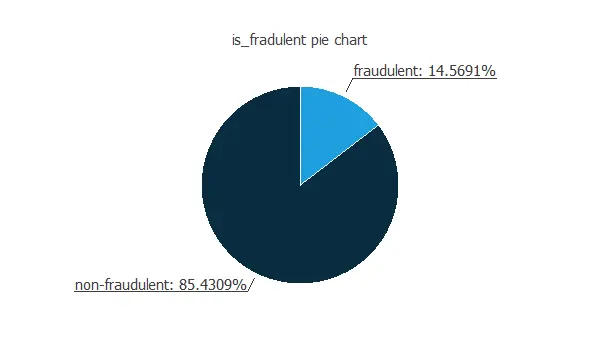
As we can see, the target variable is unbalanced, with many payments being non-fraudulent (approximately 85%), while only 15% are fraudulent. We could say that approximately 1 out of 6 payments is fraudulent.
Inputs-targets correlations
The input-target correlations might indicate which factors have the most significant influence on a fraudulent transaction.
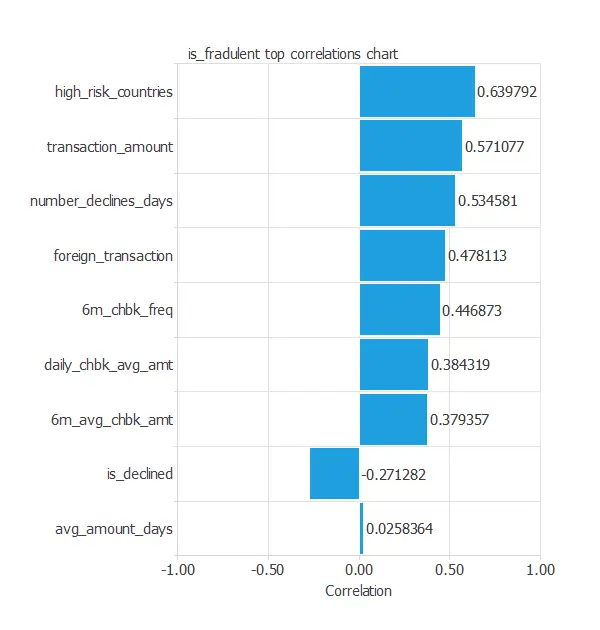
In this example, all variables have a positive correlation except for is_declined. Moreover, the variable high_risk_country has the highest correlation with the target variable.
3. Neural network
The next step is to set the neural network parameters. For classification problems, it is composed of:
- Scaling layer.
- Perceptron layers.
- Probabilistic layer.
Scaling layer
We have set the mean and standard deviation scaling method for the scaling layer,
Dense layers
We set up one perceptron layer with 3 neurons, using the logistic activation function. This layer has nine inputs, and since the target variable is binary, it has only one output.
The neural network for this example can be represented with the following diagram:
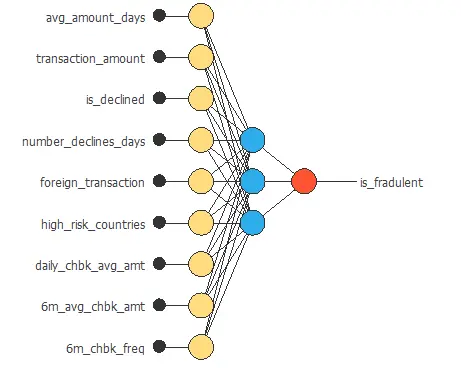
4. Training strategy
The fourth step is to set the training strategy, defining what the neural network will learn. A general training strategy for classification is composed of two terms:
- A loss index.
- An optimization algorithm.
Loss index
The loss index chosen for this problem is the normalized squared error between the neural network’s outputs and the targets in the data set with L1 regularization.
The selected optimization algorithm is the Quasi-Newton method. The selected optimization algorithm is the Quasi-Newton method.
The following chart illustrates how training and selection errors evolve over the course of training epochs. The final values are a training error of 0.052 and a selection error of 0.103, both measured in NSE.
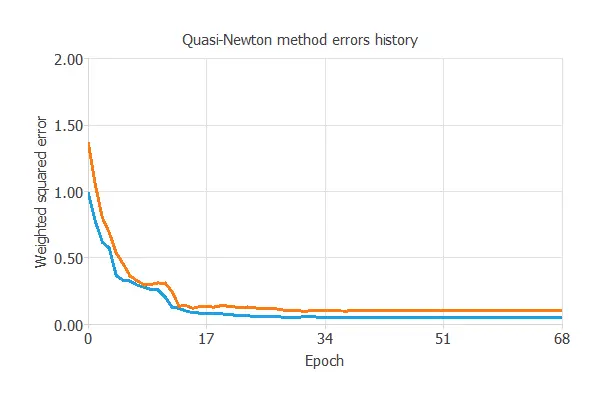
5. Model selection
The objective of model selection is to find the network architecture with the best generalization properties, which means the one that minimizes the error on the selected instances of the data set.
More specifically, we want to find a neural network with a selection error smaller than 0.103 NSE, which is the value we have achieved.
Order selection algorithms train several network architectures with a different number of neurons and select the one with the smallest selection error.
The incremental order method starts with a few neurons and increases the complexity at each iteration. The following chart shows the training error (blue) and the selection error (orange) as a function of the number of neurons.
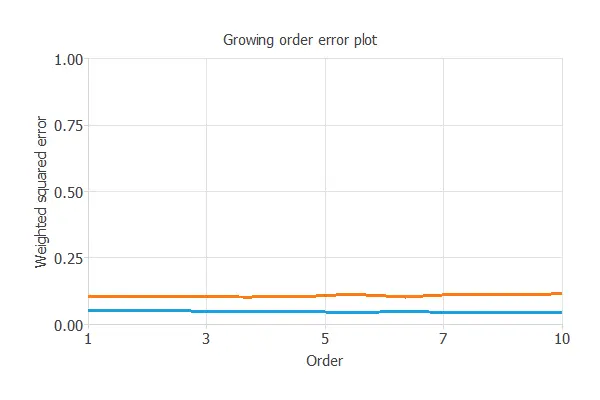
The selection errors achieved are similar for any number of variables; however, the smallest is 0.1007 for an optimal number of neurons of 4.
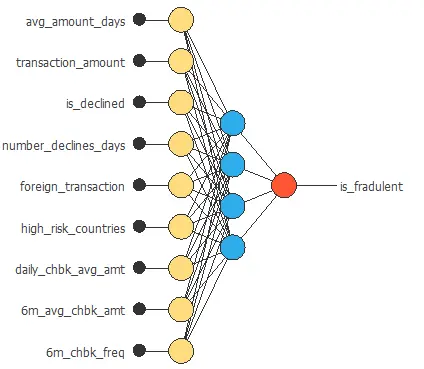
The graph above represents the architecture of the final neural network.
6. Testing analysis
The objective of the testing analysis is to validate the generalization performance of the trained neural network. To validate a classification technique, we need to compare the values provided by this technique to the observed values.
ROC curve
We can use the ROC curve as it is the standard testing method for binary classification projects.
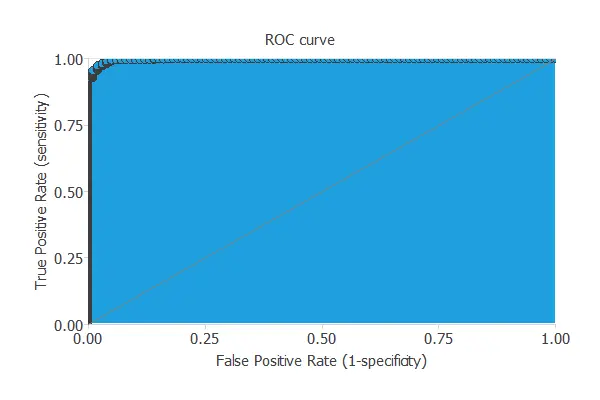
The AUC value for this example is 0.998.
Confusion matrix
The following table contains the elements of the confusion matrix.
This matrix contains the true positives, false positives, false negatives, and true negatives for the variable is_fraudulent.
| Predicted positive | Predicted negative | |
|---|---|---|
| Real positive | 79 (12%) | 5 (0%) |
| Real negative | 8 (1%) | 523 (85%) |
The total number of testing samples is 615. Therefore, the number of correctly classified samples is 602 (97%), and the number of misclassified samples is 13 (2%).
Binary classification tests
The binary classification tests are parameters for measuring the performance of a classification problem with two classes:
- Classification accuracy (ratio of instances correctly classified): 97.9%
- Error rate (ratio of instances misclassified): 2.1%
- Sensitivity (ratio of real positives the model classifies as positives): 94%
- Specificity (ratio of real negatives the model classifies as negatives): 98.5%
We have correctly classified 94% of the fraudulent payments, enabling us to identify approximately 19 out of 20 fraudulent charges.
We can also observe these results in the positive rates chart:
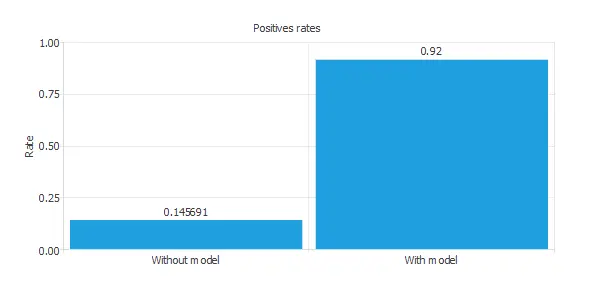
The initial positive rate was approximately 15%, and after applying our model, it has increased to 92%. This means we could recognize six times more fraudulent payments with this model.
Cumulative gain
We can also perform a cumulative gain analysis, a visual aid that shows the advantage of using a predictive model over randomness.
It consists of three lines. The baseline represents the results that would be obtained without using a model. The positive cumulative gain is shown on the y-axis as the percentage of positive instances found against the population represented on the x-axis.
Similarly, the negative cumulative gain indicates the percentage of negative instances found within the population.
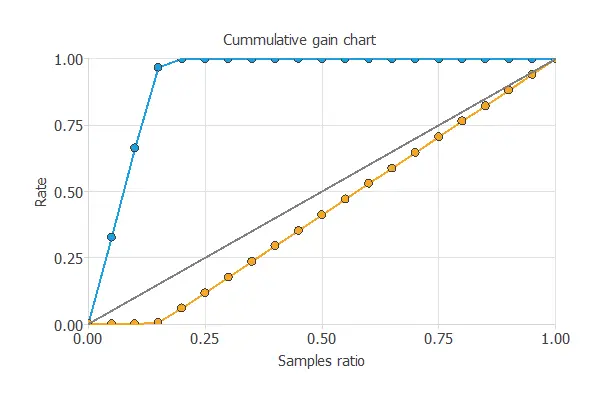
In this case, by using the model, we see that analyzing 20% of the payments with a higher probability of being fraudulent would enable us to reach 100% of the fraudulent charges.
7. Model deployment
After all the steps, the model obtained is not the best for achieving this goal. Nevertheless, it is still better than randomly guessing.
We can calculate the neural network outputs for a given set of inputs:
- avg_amount_day: 515.026.
- transaction_amount: 9876.4.
- is_declined: no.
- number_declines_day: 0.957398.
- foreign_transaction: yes.
- high_risk_country: yes.
- daily_chbk_avg_amt: 55.7376.
- 6m_avg_chbk_amt: 40.0224.
- 6m_chbk_freq: 0.39187.
The predicted output for these input values is the following:
- is_fraudulent: 96% probability of being fraudulent.
The following listing shows the mathematical expression of the predictive model.
scaled_avg_amount_days = avg_amount_days*(1+1)/(2000-(4.01153))-4.01153*(1+1)/(2000-4.01153)-1; scaled_transaction_amount = transaction_amount*(1+1)/(108000-(0))-0*(1+1)/(108000-0)-1; scaled_is_declined = is_declined*(1+1)/(1-(0))-0*(1+1)/(1-0)-1; scaled_number_declines_days = number_declines_days*(1+1)/(20-(0))-0*(1+1)/(20-0)-1; scaled_foreign_transaction = foreign_transaction*(1+1)/(1-(0))-0*(1+1)/(1-0)-1; scaled_high_risk_countries = high_risk_countries*(1+1)/(1-(0))-0*(1+1)/(1-0)-1; scaled_daily_chbk_avg_amt = daily_chbk_avg_amt*(1+1)/(998-(0))-0*(1+1)/(998-0)-1; scaled_6m_avg_chbk_amt = 6m_avg_chbk_amt*(1+1)/(998-(0))-0*(1+1)/(998-0)-1; scaled_6m_chbk_freq = 6m_chbk_freq*(1+1)/(9-(0))-0*(1+1)/(9-0)-1; perceptron_layer_0_output_0 = sigma[ -0.730652 + (scaled_avg_amount_days*0.347961)+ (scaled_transaction_amount*-0.866882)+ (scaled_is_declined*0.698547)+ (scaled_number_declines_days*-0.679199)+ (scaled_foreign_transaction*-0.744385)+ (scaled_high_risk_countries*-0.223877)+ (scaled_daily_chbk_avg_amt*-0.948853)+ (scaled_6m_avg_chbk_amt*0.281616)+ (scaled_6m_chbk_freq*-0.272766) ]; perceptron_layer_0_output_1 = sigma[ 0.757568 + (scaled_avg_amount_days*0.0680542)+ (scaled_transaction_amount*-0.254028)+ (scaled_is_declined*-0.58905)+ (scaled_number_declines_days*0.920654)+ (scaled_foreign_transaction*0.0759888)+ (scaled_high_risk_countries*0.961853)+ (scaled_daily_chbk_avg_amt*0.0324707)+ (scaled_6m_avg_chbk_amt*0.283447)+ (scaled_6m_chbk_freq*0.200012) ]; perceptron_layer_0_output_2 = sigma[ -0.406372 + (scaled_avg_amount_days*0.268921)+ (scaled_transaction_amount*0.124512)+ (scaled_is_declined*0.815247)+ (scaled_number_declines_days*-0.362366)+ (scaled_foreign_transaction*0.486023)+ (scaled_high_risk_countries*0.997009)+ (scaled_daily_chbk_avg_amt*0.286682)+ (scaled_6m_avg_chbk_amt*0.97644)+ (scaled_6m_chbk_freq*-0.848083) ]; perceptron_layer_0_output_3 = sigma[ 0.529846 + (scaled_avg_amount_days*-0.871521)+ (scaled_transaction_amount*0.977722)+ (scaled_is_declined*-0.771179)+ (scaled_number_declines_days*0.671753)+ (scaled_foreign_transaction*-0.0239868)+ (scaled_high_risk_countries*-0.501465)+ (scaled_daily_chbk_avg_amt*0.620178)+ (scaled_6m_avg_chbk_amt*-0.797546)+ (scaled_6m_chbk_freq*-0.429626) ]; probabilistic_layer_combinations_0 = -0.745667 -0.556274*perceptron_layer_0_output_0 -0.661987*perceptron_layer_0_output_1 +0.70813*perceptron_layer_0_output_2 -0.882507*perceptron_layer_0_output_3 is_fradulent = 1.0/(1.0 + exp(-probabilistic_layer_combinations_0);
This formula can also be exported to the software tool the company requires.
8. Video tutorial
You can watch the step-by-step tutorial video below to help you complete this Machine Learning example for free using the powerful machine learning software Neural Designer.
References
- The data for this problem has been taken from the Machine Learning Kaggle Repository.



